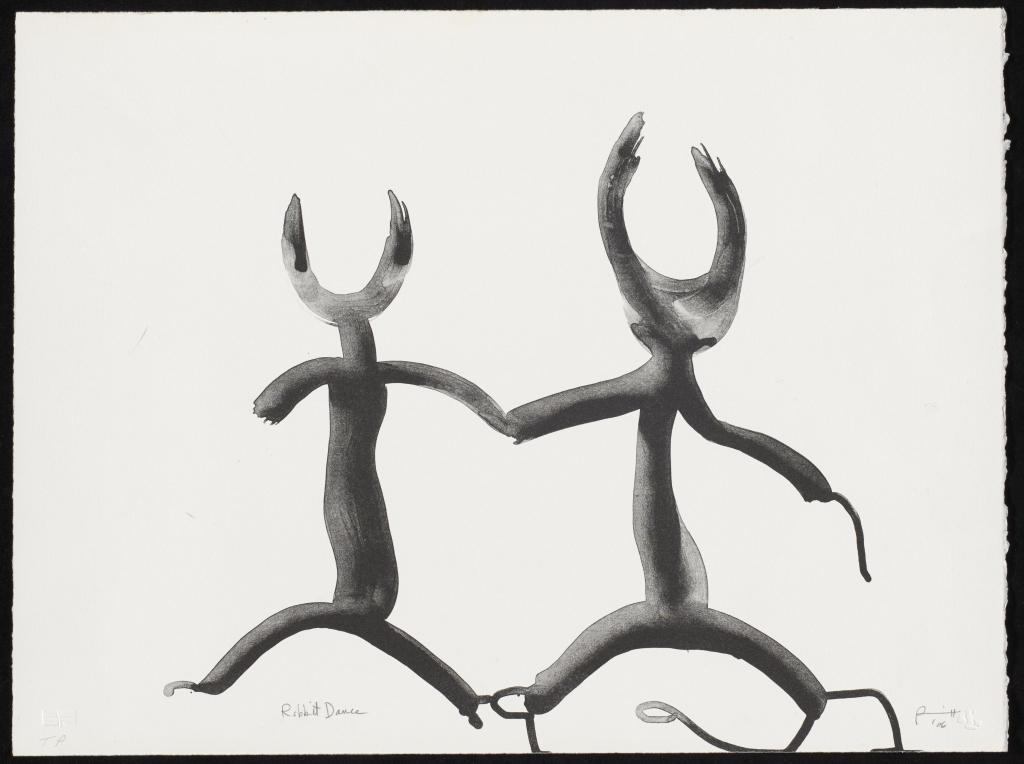Lillian Pitt (Warm Springs, Wasco, and Yakama) was born on the Warm Springs Reservation in 1944 and moved to Portland in the early 1960s after graduating from Madras High School. When back problems threatened her career as a hairdresser in the 1970s, she began taking art classes at Mount Hood Community College and took up ceramics, initially making masks. Important early artistic influences included the sculptor and painter R.C. Gorman (Navajo) and Japanese mask-making and ceramic traditions.
In the decades since, Pitt has become known for an iconography rooted in the Columbia River petroglyphs of her ancestors. Pitt’s interpretation of the petroglyph "She Who Watches" (Tsaglaglal, the Bear Woman Chief) is one of her most recognizable images. The original petroglyph is located just west of the now-flooded Celilo Falls, above the site of Pitt’s paternal grandmother’s home village. Through her use of this and other petroglyph symbols, Pitt has helped to bring the Indigenous iconography of the Columbia River to the public eye and affirm the ancient as well as contemporary Indigenous presence in the region.
Pitt is a master at reanimating the ancient images drawn and carved on rock. In the 1990s, she began working in several media in addition to clay, including precious metals, to create jewelry, bronze masks, and sculptures. She collaborated with the Pendleton Woolen Mills to create blankets featuring her interpretations of Columbia River legends and petroglyphs.
In 2000, the Army Corps of Engineers commissioned her to make a series of bronze plaques based on petroglyph imagery for Columbia River tribal in-lieu fishing sites, very appropriate given that dams had flooded many significant rock art sites along the Columbia. In the same year, Pitt’s work took an expansive leap outward when she was awarded a fellowship from Portland’s Interstate Firehouse Cultural Center to create large-scale bronze sculptures. Building on these successes, Pitt began to seek out public arts projects in the early 2000s, often working in collaboration with other artists, such as Rick Bartow (Wiyot), Gail Tremblay (Onondaga/Miqmak), and Elizabeth Woody (Navajo/Warm Springs), her niece.
Two such projects are the Trimet Yellow Line extension project in north Portland, where she conceptualized two major installations of public art (at the North Portland Boulevard Station of the Interstate Max Line stop and the Ainsworth Green Space), and the “Voices” installation of twenty-six bronze plaques at the Oregon Convention Center in Portland celebrating and commemorating Oregon tribal history. At the Yellow Line's Rosa Parks Station, Pitt's contributions included platform pavers that incorporate a Klickitat basket design and guardrail panels with thunderbird and salmon petroglyph designs. Pitt also executed a major sculpture for the Native American Student and Community Center at Portland State University: a 50-foot pole of reclaimed timber from Mount St. Helens that, with a pair of aluminum salmon at the top, marks the journey of Northwest's iconic species up and down the Columbia River.
Pitt has been a significant partner in the Confluence Project, a collaborative effort of Pacific Northwest tribes, renowned artist Maya Lin, civic groups from Washington and Oregon, and other artists, architects, and landscape designers. The project, begun in 2002, stretches more than three hundred miles from near the mouth of the Columbia River to the confluence of the Clearwater and Snake Rivers in Idaho, retracing some of the sites visited by Lewis and Clark in 1805-1806. Pitt’s work is centrally featured in the Vancouver Land Bridge site of the Confluence Project (dedicated in 2008). There, she designed a Welcome Gate for the river side of the Land Bridge that features crossed oars inset with glass masks honoring Chinook women.
Throughout her career, Pitt has remained deeply committed to her Warm Springs community, routinely donating her artwork for community charitable causes and giving her time to youth seeking guidance and artistic instruction. The recipient of many major awards, from the 1990 Governor’s Arts Award to the High Desert Museum’s 2007 Earle A. Chiles Award for Lifetime Achievement, Lillian Pitt has made significant contributions to the cultural life of Oregon.
-
![]()
Lillian Pitt.
Courtesy Lillian Pitt -
![]()
"Rabbit Dance," by Lillian Pitt, 2006.
Courtesy Portland Art Museum -
![]()
"Coyote," by Lillian Pitt, 2005.
Courtesy Portland Art Museum -
Sculpture by Lillian Pitt at the Native American Student and Community Center, Portland State University, 2012.
Courtesy Another Believer, Wikimedia Commons
Related Entries
-
Celilo Falls
Celilo Falls (also known as Horseshoe Falls) was located on the mid-Col…
-
![Elizabeth Woody (1959-)]()
Elizabeth Woody (1959-)
Poet and artist Elizabeth Woody was named Oregon Poet Laureate in 2016,…
-
![High Desert]()
High Desert
Oregon’s High Desert is a place apart, an inescapable reality of physic…
-
![Native Art of the Wapato Valley]()
Native Art of the Wapato Valley
Sauvie Island, at the confluence of the Willamette and Columbia Rivers,…
-
![Pendleton Woolen Mills]()
Pendleton Woolen Mills
Pendleton Woolen Mills opened in 1909 in a defunct woolen mill that had…
Map This on the Oregon History WayFinder
The Oregon History Wayfinder is an interactive map that identifies significant places, people, and events in Oregon history.
Further Reading
Barber, Katrine. "Heart, Head, and Hands." Columbia: The Magazine of Northwest History 21:3 (Fall 2007), 34-38.
Pitt, Lillian, et al. Spirits Keep Whistling Me Home: The Works of Lillian Pitt. Warm Springs, Ore.: The Museum at Warm Springs, 1999.
Taylor, Sue. "Lillian Pitt at the Museum of Warm Springs." Art in America 88:3 (2000), 139.









